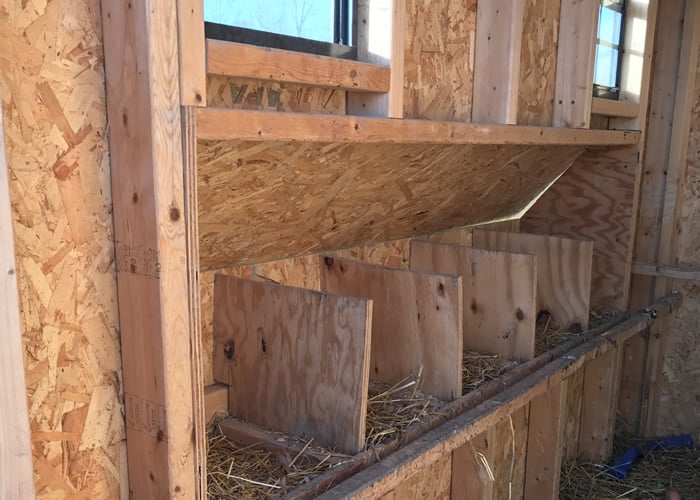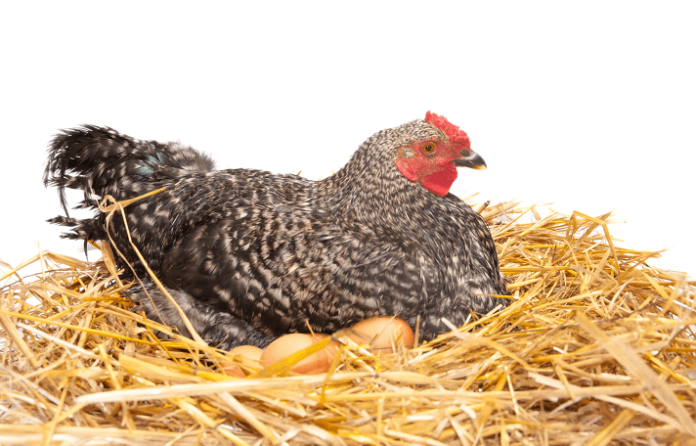Last Updated on July 2, 2021 by Fumipets
Hens do not need nesting boxes to lay eggs. They can (and do) lay in places where they feel safe.
However, the nesting box is a must-have for you, the flock keeper, unless you prefer exploring the yard, barns, and behind every shrub or overhang for eggs!
We’ll go over the fundamentals of nesting boxes in this article, including the best location, suggested sizes, and how many you’ll need for your flock.
Then we show you both store-bought and DIY models with straightforward step-by-step directions for making your own. We’ll show you the different varieties and discuss their benefits and drawbacks.
To attract a hen, the nesting box must be Peaceful, Protected, Darkening and secluded
These four factors will urge the hen to lay her eggs in the box. She will not utilise the box if it is placed in a loud, bustling location where everyone can see her. For certain things, a female wants her privacy!
Placement
The boxes should be put in an area of the coop that is somewhat dark and not overcrowded. The height of the nest box should be at least 18 inches from the ground, but it may be as high as a few feet.
If they’re the same height as your roosting bars, your hens could end up sleeping in the boxes! Even while this isn’t a significant setback, you’ll become bored of cleaning out the nest boxes every morning.

How Many Nesting Boxes Do You Need?
There is no unanimous consensus on how many nest boxes you should have for your flock.
According to a handful of government websites, one box should go for seven hens. Most people, however, use one box for every 3-4 hens. This figure is in conformity with animal welfare organisations’ recommendations for the “5 Freedoms.” You must have one for every five chickens if you want your flock to be “certified humane.”
One interesting thing is that no matter how many boxes you construct, they will not be enough! They’ll all be vying for the same box at the same time.
Size
For regular hens like Leghorns, Sussex, Plymouth Rocks, and hybrid layers, a normal nest box should be a 12-inch cube, 12 inches tall, broad, and deep. This is a good fit for the ordinary hen.
However, larger birds, like Jersey Giants, will need a nest that is 12 inches deep, 14 inches broad, and 12 inches tall.
A somewhat smaller box, 10 inches deep, 12 inches wide, and 10 inches high, may be enough for bantam chickens.
The box should be made tight with these measurements, and there’s a reason for it. The chickens will kick out the bedding stuff if they have too much space. It also prevents chickens from roosting together in order to lay eggs.
Which Materials Should You Use for Nesting?
You may use a variety of different nesting materials. We’ll go through the most common materials utilised in the following sections.Pine
Straw: Straw is another popular choice among chicken keepers. These are normally available from a local farmer or farm shop.
Sawdust: Sawdust may be gotten for free or for a very low price from a sawmill or a neighbour.
Leaves: Raking and collecting all the fallen leaves in the autumn will not only provide free bedding for your women, but it will also offer you a good exercise.
Pine Shavings: Pine shavings are simple to get by. They’re sold in handy bales at most agricultural shops.
Pine needles: If you have access to a local source, pine needles are free to take! The nicest pine needles are the softer ones.
Nesting pads: They are available at most hatcheries and on the internet. Nesting pads are both washable and affordable.
Any of these items, alone or in combination, may be used as nesting materials.
Add some fresh herbs to the boxes to help the hens to relax while laying and to discourage pests. Lavender promotes calm, while lemon balm has a fresh citrus scent and also serves as a pest deterrent.
Training Hens to Lay in nests
It’s not difficult to teach your hens to use the boxes, but you must begin training before they begin to lay.
In most cases, putting a golf ball, ping pong ball, or a fake egg in the nest boxes gives them the appropriate notion.
They may not grasp it right first, but they will ultimately figure it out and use the boxes appropriately.
If your hens refuse to use the boxes, attempt to figure out why. Is it becoming too public? Is it too loud? Maybe there aren’t enough nest boxes for them. Consider fixing any flaws you identify, but if they still refuse to use the boxes, try an alternative method.
Keep them in the coop until they’ve deposited eggs, and only provide bedding for the nesting boxes. Please do this for a few days and then let them out to see what happens.
Some chickens are stubborn about not using nest boxes, and nothing you do will persuade them otherwise. Newer chickens that have been merged with older chickens will rapidly get the concept, and you won’t need to do anything to help them.

Readymade Nest Boxes
If you aren’t too handy with tools or don’t have the time to create your own, store-bought nesting boxes can suffice.
They may be made of wood, although metal and plastic are the most popular materials.
Plastic
Plastic Laying Boxes Ready-made plastic laying boxes are the cheapest on the market, and they’re great for novices and small flocks.
Because you purchase them separately, you have the option of installing them outside the coop or in other suitable areas (such as nearby trees or outbuildings).
They’re also quite simple to clean since they’re made of plastic.
Metals
For small to medium-sized flocks, metal crates are the best option. They’re simple to keep clean, can resist a lot of damage, and are quite light in comparison to wood.
Metal nesting boxes are often more durable than their plastic or wooden equivalents, making them more suited for bigger breeds like Jersey Giants.
Most metals come in multiples of 2-10 boxes, while traditional nest boxes are supplied individually.
There’s also the ‘rollaway’ nest box to consider.
They may be constructed of plastic or metal, although the metal ones are often superior.
The egg in a rollaway box is encouraged to roll away from the hen by the slightly sloping floor. This keeps the egg significantly cleaner and eliminates pecking or unintentional breaking from trampling.
The eggs will roll to the front or rear of the box, where you can easily gather them.
Best DIY Plans

WhiteNest
The WhiteNest is a simple, classic design; it even has a vaulted ceiling. Like the “GooseBox,” this design is also portable, meaning you can place them throughout the run to provide your girls some privacy.

BucketEgg
Each one of these buckets will provide enough space for 3 egg-laying hens. You can use them as free-standing, or you can fix them to a wall. My preference is wall mounting them because the hens seem to prefer this.

ToteNest
What I love about this creation is the simple yet effective nature of it. Anybody can build one of these, and it takes a matter of minutes. Each nesting box can accommodate up to 3 laying hens, so just repeat as many times as needed for your flock.

EasyEgg
This is one of the largest nesting box designs featured in this list. It has an inventive design, which makes collecting the eggs very easy. The downside to this particular style is that you need to fit it into an existing coop to work properly.

PlasticBowls
If you don’t want to spend much money, this nesting box is for you. Each ‘nest’ costs $1 and will accommodate up to 3 hens. Just remember to place them in a sheltered, private space.

TheTriplex
The Triplex is an affordable and versatile nesting box. My favorite feature about this particular design is the roosting rail fitted to the front of the box. If you’re building this as a portable nesting box, remember to fit a wooden back to it.

GooseBox
Don’t be fooled by the name. Although they are called goose nesting boxes, they are perfectly suitable for chickens. This simple A-Frame design is cheap and quick to build. These boxes are also portable so that you can place them throughout your run.

ToyNest
This large nesting box was originally designed as a toy store. Built in under a day, it is suitable for larger flocks and can accommodate up to 27 egg-laying hens.

BucketNest
The BucketNest is one of the simplest and most innovative designs featured here. Made from a recycled 5-gallon plastic bucket, each nest will accommodate up to 3 chickens. Remember to keep the lids; they are used to keep the bedding material inside the bucket.

SwedishNest
The SwedishNest is an expensive nesting box to build. I’d only recommend this style if you’re having problems with egg eating and breakages; its roll-away design will prevent these problems.

BeeBeeNest
This huge nesting box can accommodate up to 24 laying hens. One of my favorite features of this plan is the roll-away design. It stops egg eating and also prevents accidental breakages.

RaidersNest
Again this is a straightforward nest box to create and requires very little DIY know-how. This particular layout is suitable for 18 laying hens, but you can add and remove crates to make them suitable for your flock.

WineBarrel
Built by Lisa from Fresh Eggs Daily, this nesting box started as a wooden half wine barrel. Each nesting box takes around 10 minutes to ‘build’ and accommodate up to 3 laying hens.
Accessorize Your Nesting Box
With some basic accessorising, you can make any of the blueprints above into a one-of-a-kind design.
Curtains are important! Hens like seclusion while laying their eggs, so hanging a simple curtain over the door will keep her safe from prying eyes.
These curtains do not need the use of a sewing machine. Burlap sacking, feed sacks, old napkins from the ‘nearly new’ store, or old tea towels you no longer use are all good options. They may be held in place using staples or a push pin; it doesn’t have to be elaborate.
Conclusion
Your chickens will all want the same box at the same time! If that doesn’t work, they’ll lay their eggs somewhere else and you’ll have to look for them. Even if they have been taught to use boxes, they may sometimes lie down someplace else if it pleases them.
As a result, create a couple additional warm spots for them to use if they so choose.
The nest box should have a 4-inch lip unless you’re using “open plan” boxes to prevent the egg from rolling out and breaking.
So, if you don’t want to play hide and seek with your chickens, get a nesting box. They’re inexpensive to purchase, much easy to create, and important.


















